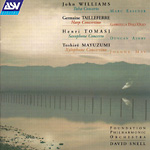John Williams’ 1985 Tuba Concerto inevitably brings to mind his ubiquitous film music, the most obvious connection being the Mothership duet from Close Encounters (there’s a bit of E.T. as well). Some listeners also will detect the strong influence of William Walton. In any event, Williams’ solo tuba writing attempts to make this hefty instrument sound graceful, but the part’s trick maneuvers and rapid runs (which Marc Easener negotiates which much strain and sweat) more readily invoke the image of Disney’s dancing hippopotami. Ultimately, the not very compelling melodic material (surprising from this composer) keeps the work from lingering very long in the memory.
Germaine Tailleferre’s (1892-1983) far more engaging Harp Concertino (1928) comes as a refreshing aperitif, with its light yet pungent textures and crisp, colorful solo writing (eloquently realized by Gabriella Dall’olio). Henri Tomasi quite naturally incorporates jazz elements in his 1949 Saxophone Concerto (the solo part, smartly played by Duncan Ashby, is deliciously bluesy), a work that emulates Ravel in its orchestration, harmonies, and use of quintuple meters.
Much of the solo writing in Toshiro Mayuzumi’s Xylophone Concertino is of the expected jocular variety–except in the slow movement, where the xylophone, in the able hands of Joanne May, plays a beautiful Japanese melody in quiet sustained tones. David Snell leads the Foundation Philharmonic in generally decent accompaniments, though I’ve heard Williams’ syncopated string figures played with truer intonation and tighter rhythms. The recordings place the performers in a favorable perspective with pleasing balances between soloists and orchestra.
































